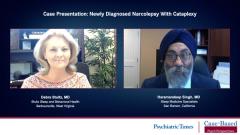
Presentation of Cataplexy in Patients With Narcolepsy
In this custom video series, experts in sleep medicine provide insight on ways cataplexy can present in patients with narcolepsy.
Episodes in this series

Haramandeep Singh, MD: When we talk about classic cataplexy, we know that cataplexy generally doesn’t present in this manner. I’d love to hear your thoughts on how cataplexy generally presents in your practice, how you recognize it, and how you differentiate from other diagnoses often given to these patients who may have partial cataplexy.
Debra Stultz, MD: I remember a very similar case from when I was in medical school. The patient had narcolepsy and fell on the floor. It was very dramatic. In my mind, I thought, “When I see that, I’ll know that’s cataplexy.” I’ve worked in sleep medicine for many years now, so I realize that cataplexy can present in a variety of ways and is often very subtle. The other thing that’s important to note is patients sometimes aren’t the best historians about cataplexy. They may not even realize that when they laugh or have a strong emotion, they’re doing something unusual with their face or they’re having a muscle collapse or something. Cataplexy is a symptom where if they say no, then I say, “I want you to think about this. I want you to ask the people around you.” Sometimes you’ve got to get third-party history to get the symptom of cataplexy.
Cataplexy is any muscle weakness with a strong emotion. It can occur with laughter and anger, which are the most common. But it can also occur with frustration, sexual excitation, disgust, being surprised. I’ve read that if somebody meets up with an old friend and they’re surprised and emotional at the same time, that can cause it. For other people, listening to music that’s very moving to them can cause some cataplexy. Music can move them. Any strong emotion that causes the muscle weakness is cataplexy.
The presentation is different for everybody. When I talk to my patients, I’ll ask them about cataplexy starting from the head and working my way down. Some have a strong emotion and have their head drop; that’s pretty common. But you can have drooping eyelids, blurred vision, or weakness in the tongue muscles. Sometimes patients will stutter. Weakness in the jaw is especially common in pediatric cases of narcolepsy, where the jaw thrusts forward and the tongue may protrude a little. It almost looks like Down syndrome. Other presentations can be shoulder weakness, arm weakness, weakness of the hand, buckling of the knees, and ankles getting weak. It can be very subtle or more dramatic. It can almost look like a tic. I call it a reverse of a tic, because they get the muscle weakness and then it comes back, so there’s almost a jerky quality. With any kind of unusual muscle movement, you should start thinking cataplexy.
Haramandeep Singh, MD: I appreciate that detailed response. I concur 100%. I’ve seen it all through the years. I had a patient the other day who told me that she was diagnosed with depression, but she told me that when she felt sad, she would have weakness in her trunk muscles of her abdomen and she’d keel over. You can see it in any manner. That’s where your radars have to be up. This is associated with any emotion that can cause weakness in any part of your body.
Debra Stultz, MD: If you’re very suspicious of it and you’re working on this diagnosis with the patient and they talk to their family, the family members can actually video with their phone. I’ve had patients bring it in, and I say, “Looks like that to me.” We’re really lucky with the electronics we have available that might be able to even see it, because it’s not often seen in your office.
Haramandeep Singh, MD: We’re lucky with today’s technology to be able to catch those things. It’s rare that you’re going to catch it in your office. It’s really important to get that history and document, with a detailed idea of what your patients are going through on a day-to-day basis in whatever aspect of their life that they’re focused on, whether it’s work or they have an incident of cataplexy at home. I appreciate your comments on that.
Transcript edited for clarity.
Disclosures:
Dr Stultz has disclosed that she serves as a consultant on the advisory board for Harmony Biosciences and that she receives support in her role with the speaker’s bureau for Harmony Biosciences and Jazz Pharmaceuticals.
Dr Singh has disclosed that he serves as a consultant and receives support in his role with the speaker's bureau for Jazz Pharmaceuticals and Harmony Biosciences.
Newsletter
Receive trusted psychiatric news, expert analysis, and clinical insights — subscribe today to support your practice and your patients.













